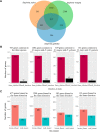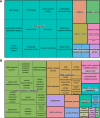Identification of General Patterns of Sex-Biased Expression in Daphnia, a Genus with Environmental Sex Determination
- PMID: 29535148
- PMCID: PMC5940145
- DOI: 10.1534/g3.118.200174
Identification of General Patterns of Sex-Biased Expression in Daphnia, a Genus with Environmental Sex Determination
Abstract
Daphnia reproduce by cyclic-parthenogenesis, where phases of asexual reproduction are intermitted by sexual production of diapause stages. This life cycle, together with environmental sex determination, allow the comparison of gene expression between genetically identical males and females. We investigated gene expression differences between males and females in four genotypes of Daphnia magna and compared the results with published data on sex-biased gene expression in two other Daphnia species, each representing one of the major phylogenetic clades within the genus. We found that 42% of all annotated genes showed sex-biased expression in D. magna This proportion is similar both to estimates from other Daphnia species as well as from species with genetic sex determination, suggesting that sex-biased expression is not reduced under environmental sex determination. Among 7453 single copy, one-to-one orthologs in the three Daphnia species, 707 consistently showed sex-biased expression and 675 were biased in the same direction in all three species. Hence these genes represent a core-set of genes with consistent sex-differential expression in the genus. A functional analysis identified that several of them are involved in known sex determination pathways. Moreover, 75% were overexpressed in females rather than males, a pattern that appears to be a general feature of sex-biased gene expression in Daphnia.
Keywords: Daphnia; Differential gene expression; ESD; Genetics of Sex; females; males.
Copyright © 2018 Molinier et al.
Figures





Similar articles
-
Profiling sex-biased gene expression during parthenogenetic reproduction in Daphnia pulex.BMC Genomics. 2007 Dec 18;8:464. doi: 10.1186/1471-2164-8-464. BMC Genomics. 2007. PMID: 18088424 Free PMC article.
-
De Novo Transcriptome Assembly and Sex-Biased Gene Expression in the Cyclical Parthenogenetic Daphnia galeata.Genome Biol Evol. 2016 Oct 23;8(10):3120-3139. doi: 10.1093/gbe/evw221. Genome Biol Evol. 2016. PMID: 27604882 Free PMC article.
-
Environmental sex determination in the branchiopod crustacean Daphnia magna: deep conservation of a Doublesex gene in the sex-determining pathway.PLoS Genet. 2011 Mar;7(3):e1001345. doi: 10.1371/journal.pgen.1001345. Epub 2011 Mar 24. PLoS Genet. 2011. PMID: 21455482 Free PMC article.
-
A molecular mechanism for environmental sex determination.Trends Genet. 2024 Oct;40(10):817-818. doi: 10.1016/j.tig.2024.07.005. Epub 2024 Jul 29. Trends Genet. 2024. PMID: 39079787 Review.
-
Males on demand: the environmental-neuro-endocrine control of male sex determination in daphnids.FEBS J. 2015 Nov;282(21):4080-93. doi: 10.1111/febs.13393. Epub 2015 Aug 21. FEBS J. 2015. PMID: 26237283 Review.
Cited by
-
A comprehensive epigenomic analysis of phenotypically distinguishable, genetically identical female and male Daphnia pulex.BMC Genomics. 2020 Jan 6;21(1):17. doi: 10.1186/s12864-019-6415-5. BMC Genomics. 2020. PMID: 31906859 Free PMC article.
-
Transcriptome analysis of different life-history stages and screening of male-biased genes in Daphnia sinensis.BMC Genomics. 2022 Aug 13;23(1):589. doi: 10.1186/s12864-022-08824-x. BMC Genomics. 2022. PMID: 35964016 Free PMC article.
-
No evidence for genetic sex determination in Daphnia magna.R Soc Open Sci. 2021 Jun 16;8(6):202292. doi: 10.1098/rsos.202292. R Soc Open Sci. 2021. PMID: 34150315 Free PMC article.
-
The role of mitochondria in sex- and age-specific gene expression in a species without sex chromosomes.Proc Natl Acad Sci U S A. 2024 Jun 11;121(24):e2321267121. doi: 10.1073/pnas.2321267121. Epub 2024 Jun 5. Proc Natl Acad Sci U S A. 2024. PMID: 38838014 Free PMC article.
-
The role of mitochondria in sex- and age-specific gene expression in a species without sex chromosomes.bioRxiv [Preprint]. 2023 Dec 9:2023.12.08.570893. doi: 10.1101/2023.12.08.570893. bioRxiv. 2023. Update in: Proc Natl Acad Sci U S A. 2024 Jun 11;121(24):e2321267121. doi: 10.1073/pnas.2321267121. PMID: 38106076 Free PMC article. Updated. Preprint.
References
Publication types
MeSH terms
Grants and funding
LinkOut - more resources
Full Text Sources
Other Literature Sources
Miscellaneous
